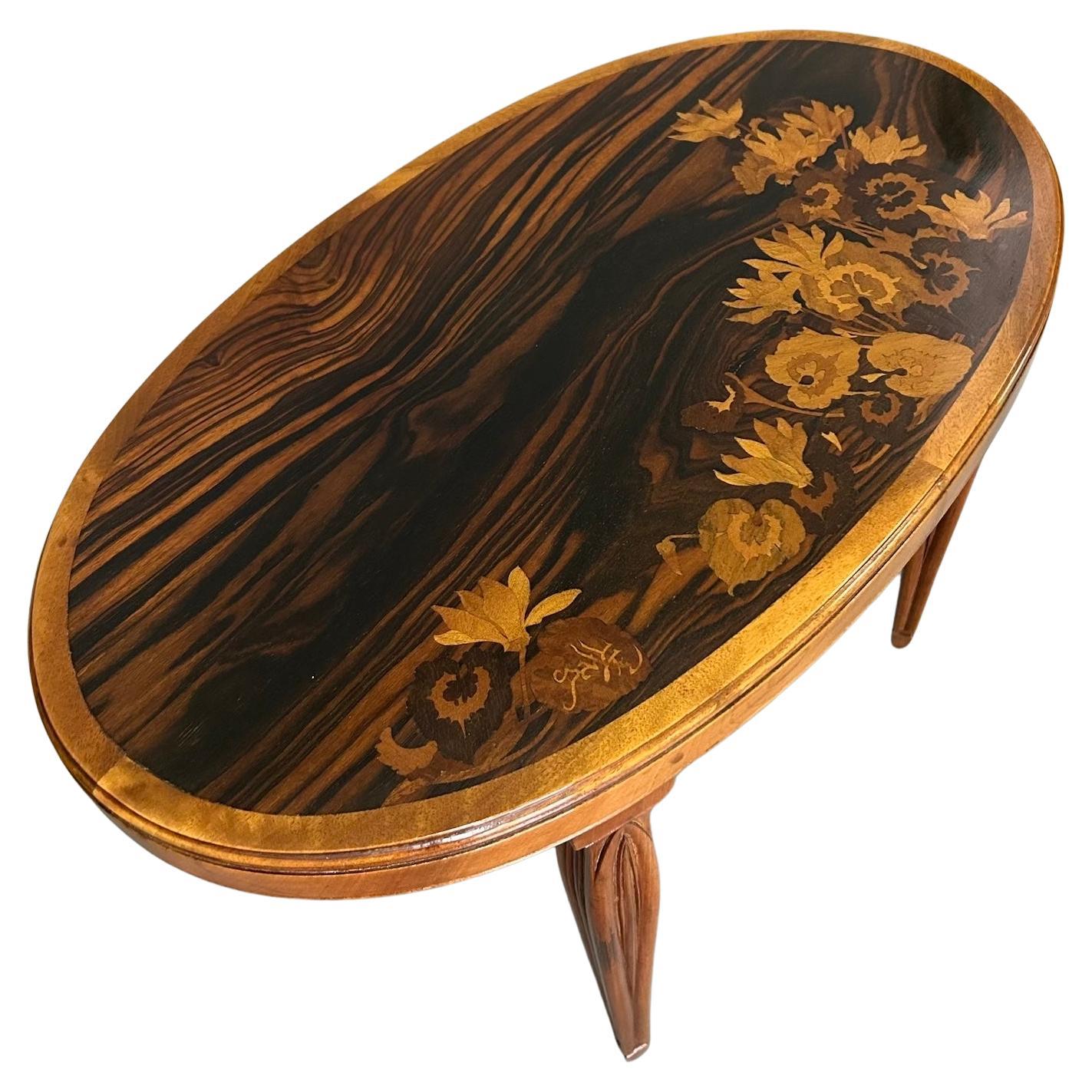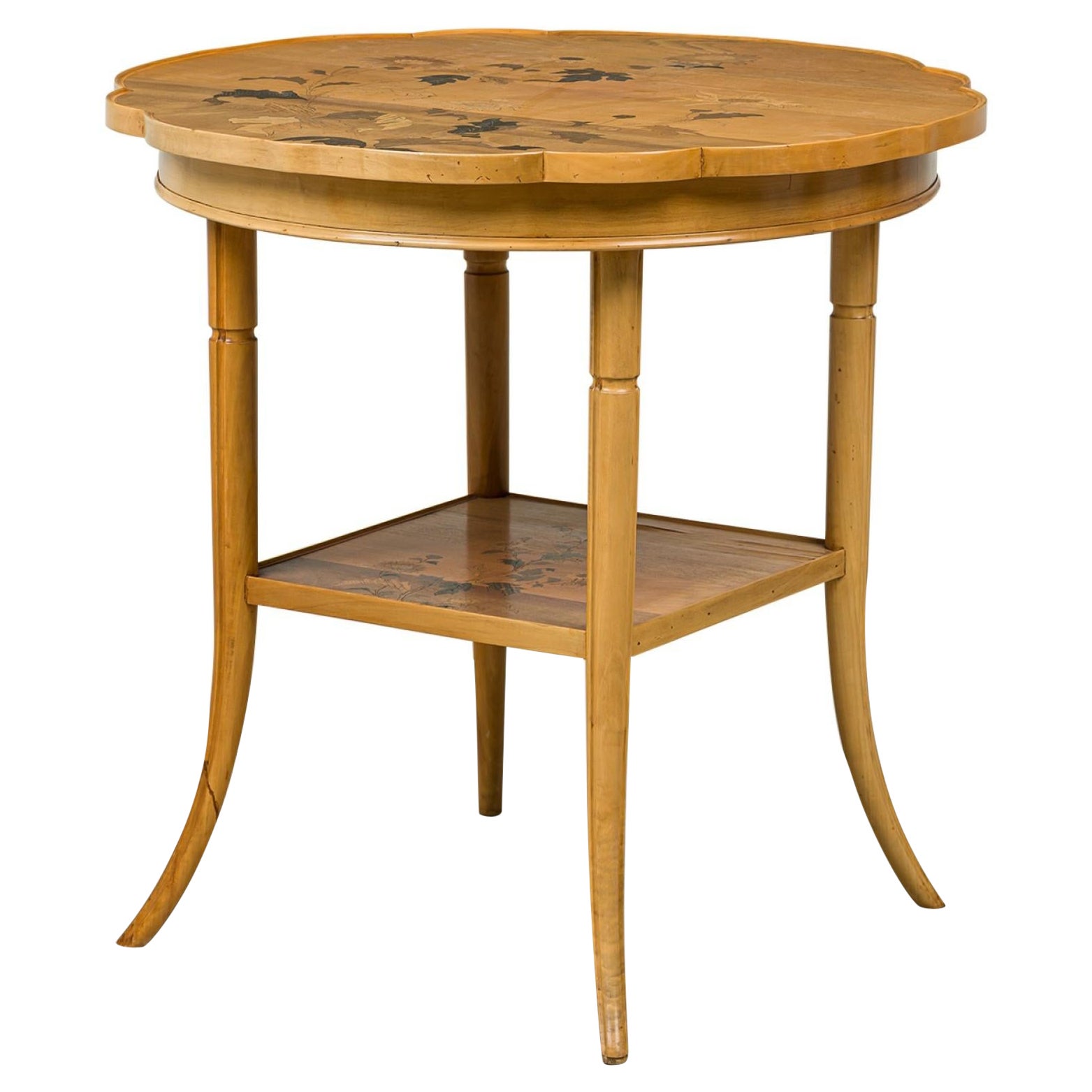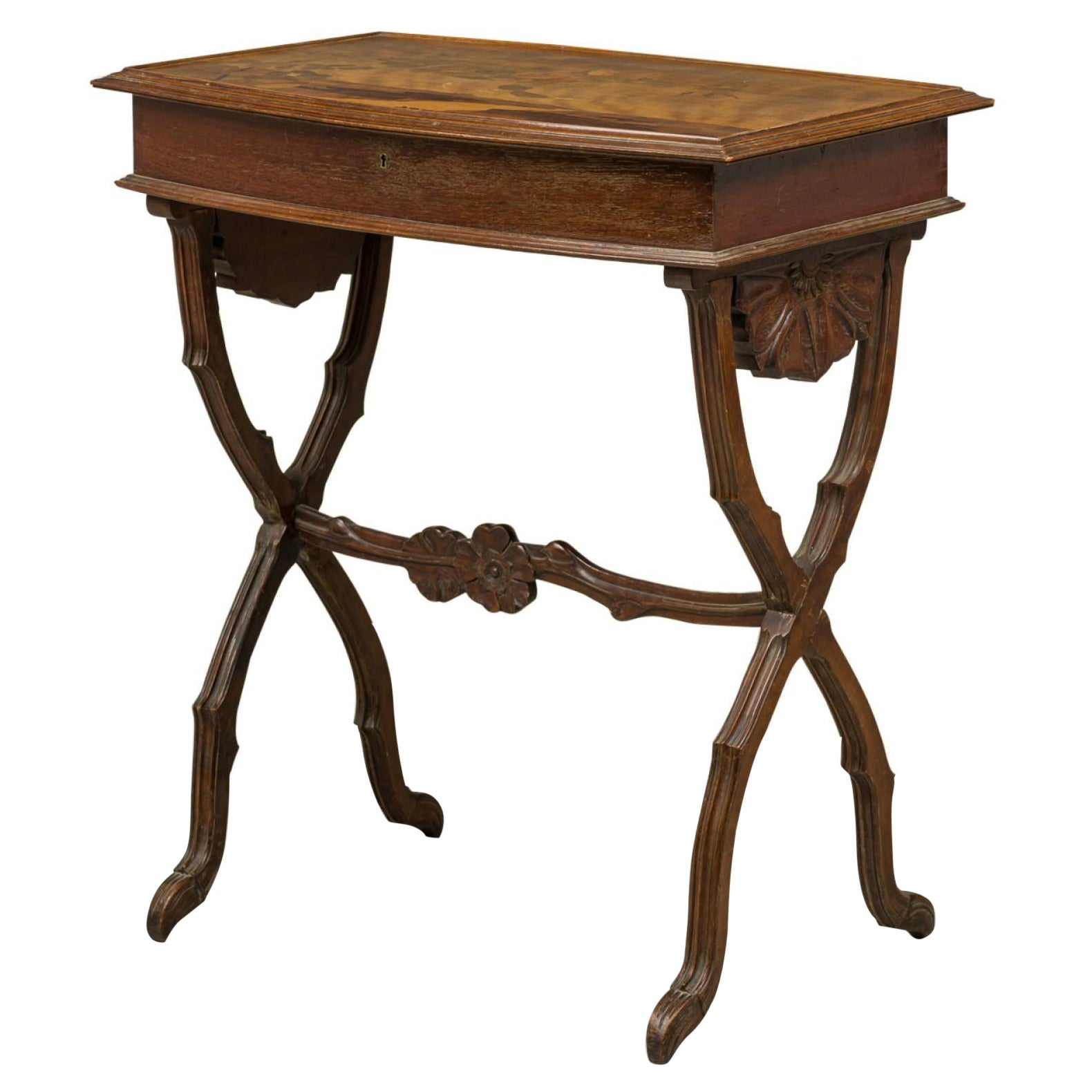Items Similar to Emile Galle "Ombelles" Floral and Pastoral Marquetry Writing Desk
Want more images or videos?
Request additional images or videos from the seller
1 of 17
Emile Galle "Ombelles" Floral and Pastoral Marquetry Writing Desk
About the Item
French Art Nouveau writing desk featuring an open upper section with a marquetry inlaid pasteral scene back panel under a carved floral crest supported by two fluted & carved columns over a drop front cabinet having a floral marquetry cabinet resting on a shaped table top with continuing floral marquetry over a single drawer with a shaped stretcher shelf, connecting four fluted sabre legs. (EMILE GALLE)
- Creator:Emile Gallé (Designer)
- Dimensions:Height: 55.25 in (140.34 cm)Width: 30.5 in (77.47 cm)Depth: 22 in (55.88 cm)
- Style:Art Nouveau (Of the Period)
- Materials and Techniques:
- Place of Origin:
- Period:
- Date of Manufacture:20th Century
- Condition:Wear consistent with age and use.
- Seller Location:New York, NY
- Reference Number:
About the Seller
4.9
Recognized Seller
These prestigious sellers are industry leaders and represent the highest echelon for item quality and design.
Gold Seller
These expertly vetted sellers are highly rated and consistently exceed customer expectations.
Established in 1939
1stDibs seller since 2013
806 sales on 1stDibs
Typical response time: <1 hour
- ShippingRetrieving quote...Ships From: Long Island City, NY
- Return PolicyA return for this item may be initiated within 2 days of delivery.
More From This SellerView All
- Emile Galle French Art Nouveau Floral Marquetry Rotating Top Occasional TableBy Emile GalléLocated in New York, NYFrench Art Nouveau occasional table with a circular top with shaped edge and floral marquetry inlay that rotates on a central axis, resting on four tapered sabre legs joined by a squ...Category
20th Century French Art Nouveau Side Tables
MaterialsWood
- Emile Galle French Art Nouveau Lift Top Marquetry Floral Inlaid Wooden TableBy Emile GalléLocated in New York, NYFrench Art Nouveau occasional / dressing table with an elaborate inlaid floral and pastoral design that lifts on two brass hinges to reveal an interior mirror and inlaid floral desig...Category
20th Century French Art Nouveau Vanities
MaterialsMetal, Brass
- Emile Galle French Art Nouveau Walnut Floral Serving TableBy Emile GalléLocated in New York, NYFrench Art Nouveau walnut and floral inlaid serving table on scroll legs with a tray form top having open handles and filigree gallery corners with a drawer (signed EMILE GALLE)Category
Early 20th Century French Art Nouveau Serving Tables
MaterialsWalnut
- Russian Walnut Marquetry Kidney DeskLocated in New York, NYRussian style (18/19th Century) walnut kidney shaped desk with marquetry inlay and open design pedestal sides with a stretcher and drawer.Category
Antique 19th Century Russian Neoclassical Desks and Writing Tables
MaterialsWalnut
- French Maison Dominique Palisander and Glass Writing DeskBy Maison DominiqueLocated in New York, NYFrench 1940s palisander writing desk with rounded rectangular glass top above 2 frieze drawers & shelves down a side. (attributed to MAISON DOMINIQUE)Category
Vintage 1940s French Art Deco Desks and Writing Tables
MaterialsGlass, Palisander
- English Regency Mahogany Writing DeskLocated in New York, NY19th century English Regency style mahogany writing table (desk) with inset green leather top above 2 frieze drawers to either side on trestle supports and splayed legs.Category
Antique Late 19th Century English Regency Desks and Writing Tables
MaterialsLeather, Mahogany
You May Also Like
- Pedestal Table Aux Ombelles by Émile GalléBy Emile GalléLocated in charmes, FRIn walnut and marquetry of different types of wood, with hollow polylobed top decorated with umbelliferae. Base with two sculpted side legs. Signed in the marquetry of the tray minim...Category
Antique Early 1900s French Art Nouveau Gueridon
MaterialsWood
- Antique Walnut and Marquetry Writing DeskLocated in London, GBThis elegant writing desk was created in France in the late 18th century, during the reign of King Louis XVI (1774-1792). The desk is designed in a refined neoclassical style which w...Category
Antique Late 19th Century French Louis XVI Desks
MaterialsBrass
- Emile Gallè Art Nouveau Marquetry Side tableBy Emile GalléLocated in Porto, PTMacassar ebony and sycamore Emile Gallè Art Nouveau floral marquetry oval side table.Category
Vintage 1910s French Art Nouveau Side Tables
MaterialsSycamore, Macassar
- Régence Style Marquetry Writing DeskLocated in Brighton, West SussexA magnificent and very rare Régence style marquetry inlaid grand bureau plat or writing desk. Inscribed to the carcass 'Moreaux 72'. Dating from the second half of the nineteenth century this magnificent and very rare bureau plat has finely cast rocaille gilt-bronze mounts and is decorated overall with truly breath-taking seventeenth century marquetry, depicting fantastical townscapes, knights, soldiers, hunting and architectural-scenes. Of serpentine rectangular form the top is veneered with superb marquetry panels within a foliate scrolled border and a rocaille shell-cast gilt-bronze surround, both sides featuring a recessed central drawer flanked on each side by a drawer applied with male and female terms, scrolled handles, and reserves with conforming drawers; the bombé sides are centred by foliate scrolls, and the whole raised on cabriole legs headed by cartouches with foliate entwined chutes terminating in scrolled sabots. Of impressive scale this fine bureau plat, in the manner of a partners desk, features working drawers to each side. This model of bureau plat was made by a small number of celebrated Parisian cabinet makers in the second half of the 19th century including Beurdeley, Cremer and Befort Jeune. It is incredibly rare to see this model of bureau plat inlaid in marquetry. The exceptional quality and style indicate the use of older reused marquetry, almost certainly dating from the late 17th century and originating from the Augsburg region of Germany. Similar models but lacking the exceptional marquetry inlay can be found in the collection of the Duke of Buccleuch at Bowhill, and the Earl of Normanton at Somerlely. Christopher Payne notes that the latter was part of a pair sold by the London dealer Toms & Luscombe in 1871. He illustrates the present bureau plat in his book ‘European Furniture of the 19th Century’ (p. 88-89), along with two related desks minus the marquetry inlay (p. 92 -93). The exceptional and highly complex marquetry inlay and intarsia work, that sets this important bureau plat apart from other extant examples, would originally have formed the decorative panels of a late 17th century table cabinet, almost certainly ascribable to the Augsburg region of Germany. Augsburg emerged from the middle of the 16th century as the German centre of luxury cabinet making for the international market. In particular, the development of marquetry contributed to this prominent position, favoured by the ready availability of indigenous woods and the reputation that Augsburg had the best craftsmen able to cut thin layers of veneers in the most intricate motifs (C.S. Wood, ‘The Perspective Treatise in Ruins: Lorenz Stöer, Geometria et perspectiva, 1567’, Studies in the History of Art, no. 59, p. 246). Table cabinets, conceived as a form of Wunderkammer or cabinets of curiosities, were intended as repositories for all manner of wondrous and exotic objects and by the 1550s the grandest cabinets in Europe were being made in Augsburg. Decorated almost entirely with sumptuous marquetry, often depicting perspective views of ruins and fantastical townscapes, they become by the 1590s highly regarded as important diplomatic gifts. Fine Augsburg marquetry panels remained popular throughout the ages and were frequently re-used to create or embellish new items of furniture, such as this magnificent bureau plat. Their inclusion was not only for their highly decorative appeal, but to contemporary eyes, a means by which to imbue a new creation with a sense of true historical authenticity. The importance of such panels is often reflected in the high cost involved in repurposing them. A fine example of this is the celebrated 17th century cabinet on stand...Category
Antique Mid-19th Century French Louis XV Desks and Writing Tables
MaterialsOrmolu
- French Art Nouveau Marquetry Table by Emile GalléBy Emile GalléLocated in Kastrup, DKEmile Gallé, 1846-1904 A French Art Nouveau tray table crafted in walnut. Table top features exquisite floral marquetry woodwork in fruitwood and different wood species. With cabinet...Category
Antique Early 19th Century French Art Nouveau Tables
MaterialsFruitwood, Walnut
- French Gilt Bronze and Marquetry Writing Desk After CressentBy Charles CressentLocated in London, GBFrench gilt bronze and marquetry writing desk after Cressent. French, late 19th century Measures: height 79cm, width 134cm, depth 76cm This very fine desk was retailed by the celebrated English retailers Edwards & Roberts and was designed and crafted in France in the manner of Charles Cressent, who worked during the early eighteenth century in the Régence style. The desk is crafted from rich dark wood finished with chequerboard marquetry and fixed with gilt bronze mounts. The desk features a flat tabletop bordered in gilt bronze, which is raised above an apron and four cabriole legs. The apron features three drawers to the front, each affixed with gilt bronze mounts in a foliate style and modelled as theatrical masks, while the sides of the apron are affixed with gilt bronze grotesques...Category
Antique Late 19th Century French Régence Desks and Writing Tables
MaterialsOrmolu
Recently Viewed
View AllMore Ways To Browse
School Desk
Louis Xv Writing Table 18th Century
Pluto Desk
Vintage Danish Writing Desk
Desk By Hans Wegner
Spindle Leg Desk
Vintage Bamboo Rattan Desk
Vintage Oak Desk Home Office Desks
Weathered Wood Desk
Desks 24 Inch Deep
Danish Desk Writing Table Sold
Vintage Oak School Desk
Antique Sheraton Writing Desk
Louis Xv Style Ladies Desk
Marble And Brass Flower Stand
Antique Pedestals Walnut Pair
Executive Desk 19th Century
Vintage Queen Anne Desk





